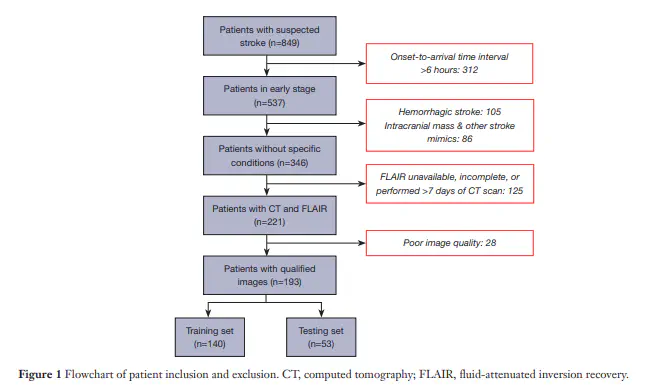Detecting brain lesions in suspected acute ischemic stroke with CT-based synthetic MRI using generative adversarial networks

Abstract
Difficulties in detecting brain lesions in acute ischemic stroke (AIS) have convinced researchers to use computed tomography (CT) to scan for and magnetic resonance imaging (MRI) to search for these lesions. This work aimed to develop a generative adversarial network (GAN) model for CT-to-MR image synthesis and evaluate reader performance with synthetic MRI (syn-MRI) in detecting brain lesions in suspected patients.
Patients with primarily suspected AIS were randomly assigned to the training (n=140) or testing (n=53) set. Emergency CT and follow-up MR images in the training set were used to develop a GAN model to generate syn-MR images from the CT data in the testing set. The standard reference was the manual segmentations of follow-up MR images. Image similarity was evaluated between syn-MRI and the ground truth using a 4-grade visual rating scale, the peak signal-to-noise ratio (PSNR), and the structural similarity index measure (SSIM). Reader performance with syn-MRI and CT was evaluated and compared on a per-patient (patient detection) and per-lesion (lesion detection) basis. Paired t-tests or Wilcoxon signed-rank tests were used to compare reader performance in lesion detection between the syn-MRI and CT data.
Grade 2–4 brain lesions were observed on syn-MRI in 92.5% (49/53) of the patients, while the remaining syn-MRI data showed no lesions compared to the ground truth. The GAN model exhibited a weak PSNR of 24.30 dB but a favorable SSIM of 0.857. Compared with CT, syn-MRI led to an increase in the overall sensitivity from 38% (57/150) to 82% (123/150) in patient detection and from 4% (68/1,620) to 16% (262/1,620) in lesion detection (R=0.32, corrected P<0.001), but the specificity in patient detection decreased from 67% (6/9) to 33% (3/9). An additional 75% (70/93) of patients and 15% (77/517) of lesions missed on CT were detected on syn-MRI.
The GAN model holds potential for generating synthetic MR images from noncontrast CT data and thus could help sensitively detect individuals among patients with suspected AIS. However, the image similarity performance of the model needs to be improved, and further expert discrimination is strongly recommended.